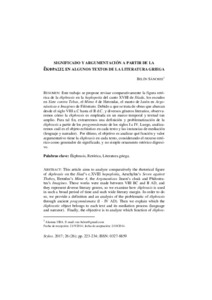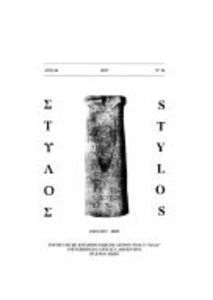Please use this identifier to cite or link to this item:
https://repositorio.uca.edu.ar/handle/123456789/9742| Título: | Significado y argumentación a partir de la ἔκφρασισ en algunos textos de la literatura griega | Autor: | Sánchez, Belén | Palabras clave: | RETORICA; LITERATURA GRIEGA; RECURSOS LITERARIOS; ECFRASIS; ANALISIS LITERARIO | Fecha de publicación: | 2017 | Editorial: | Universidad Católica Argentina. Facultad de Filosofía y Letras. Instituto de estudios grecolatinos "Prof. F. Nóvoa" | Cita: | Sánchez, B. Significado y argumentación a partir de la ἔκφρασισ en algunos textos de la literatura griega [en línea]. Stylos. 2017, 26. Disponible en: https://repositorio.uca.edu.ar/handle/123456789/9742 | Resumen: | Resumen: Este trabajo se propone revisar comparativamente la figura retó-rica de la ékphrasis en la hoplopoiía del canto XVIII de Ilíada, los escudos en Siete contra Tebas, el Mimo 4 de Herondas, el manto de Jasón en Argo-náuticas e Imagines de Filóstrato. Debido a que se trata de obras que abarcan desde el siglo VIII a.C hasta el II d.C. y diversos géneros literarios, observa-remos cómo la ékphrasis es empleada en un marco temporal y textual tan amplio. Para tal fin, extraeremos una definición y problematización de la ékphrasis a partir de los progymnásmata de los siglos I a IV. Luego, analiza-remos cuál es el objeto ecfrástico en cada texto y las instancias de mediación (lenguaje y narrador). Por último, el objetivo es analizar qué función y valor argumentativo tiene la ékphrasis en cada texto, considerando el recurso retó-rico como generador de significado, y no simple ornamento retórico digresi-vo. Abstract: This article aims to analyze comparatively the rhetorical figure of ékphrasis on the Iliad’s c.XVIII hopoploiía, Aeschylus’s Seven against Thebes, Herodas’s Mime 4, the Argonauticas Jason’s cloak and Philostra-tus’s Imagines. These works were made between VIII BC and II AD, and they represent diverse literary genres, so we examine how ékphrasis is used in such a broad period of time and such wide literary margin. In order to do so, we provide a definition and an analysis of the problematic of ékphrasis through ancient progymnásmata (I - IV AD). Then we explain which the ékphrastic object belongs to each text and its mediation process (language and narrator). Finally, the objective is to analyze which function of ékphrasis is used in each text, taking into account that this rhetorical figure works as a producer of sense and not a mere rhetorical digressive ornament. |
URI: | https://repositorio.uca.edu.ar/handle/123456789/9742 | ISSN: | 0327-8859 | Disciplina: | LITERATURA | Derechos: | Acceso abierto | Fuente: | Stylos Nº 26, 2017 |
| Appears in Collections: | STY - 2017 nro. 26 |
Files in This Item:
| File | Description | Size | Format | |
|---|---|---|---|---|
| significado-argumentacion-literatura.pdf | 279,3 kB | Adobe PDF |  View/Open | |
| stylos26.jpg | 106,33 kB | JPEG |  View/Open |
Page view(s)
163
checked on Apr 30, 2024
Download(s)
136
checked on Apr 30, 2024
Google ScholarTM
Check
This item is licensed under a Creative Commons License

